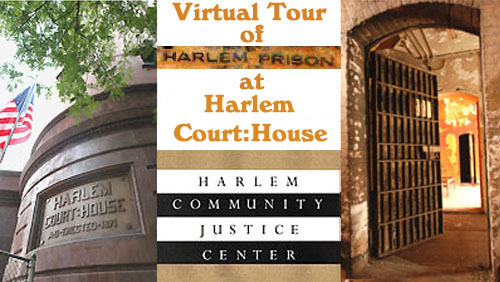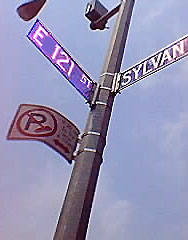
Street name signs at the intersection near the courthouse/jail complex.
|
|
After 112 years, the Harlem “district prison,” that ceased incarcerations more than half century ago, is the oldest jail structure still standing in the City of New York -- with five tiers, 40 cells, double-bunk bed frames, cell doors and other fixtures, all relatively intact from a historical perspective.
The 5th District Prison on 121st St. at Sylvan Place between 3rd and Lexington Avenues, was built four years before the New York City Department of Correction became a separate agency on its own, six years before the city became five boroughs, and a decade before the second East River span – the Williamsburg – opened (and less than decade after the Brooklyn Bridge opening).
The jail was processing prisoners, along with the original Tombs ("City Prison"), when the Penitentiary and Workhouse on Blackwell’s Island were the city’s main correctional facilities off Manhattan Island, and when Rikers was just the municipal farm colony and a landfill operation.
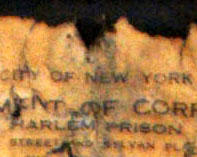
Detail from 1940s 5th District Jail letterhead shows facility was also called Harlem Prison. The above detail was cropped from an enlarged image of what remains of the official stationery on which a list of the jail's rules had been typed and displayed. A reduced version of that list appears below.
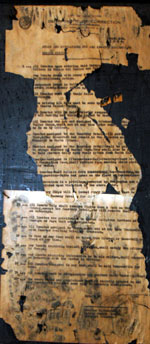
|
|
As can been seen in the detail right, cropped from a photo of the jail's 1940s printed letterhead, Harlem Prison appears to be one of the appellations officially applied to the facility that operated from approximately 1892 to 1949.
It was also known as 5th District Prison and as 5th District Jail. The Harlem Prison part of the above image detail forms part of the montage logo (top of page) for this NYCHS presentation.
The letterhead detail was cropped from a photo of a sheet of jail stationery -- discolored, badly torn, missing sections, and affixed to a bulletin board -- featuring a list of the institution's rules for inmates, including those assigned to Hart Island (Potter's Field) cemetery duty.
The district jail was part of the decentralized inmate in-take system that the city had evolved in the era before the horse was replaced by the motor vehicle.
It was the system where NYC DOC's inmate identification code -- the Book and Case Number (B&C#) -- likely had its origins, when every district jail possessed its own identifying locality digit so that an inmate’s B&C# told, in effect, where he had been first processed.
The jail also helps illustrate the long struggle in developing suitable housing for female inmates, sentenced as well as detainee, adolescent as well as adult, with the particular challenges attendant thereto. It played a pivotal role as the women’s Jefferson Market Prison was being torn down and during early 1930s construction of the Women’s House of Detention, which held such promise but proved such a failure.
There are other penal aspects to be noted: the arched cell doorways, each with an individual door made of bars set in a rectangular frame; the double-bunking, the single-access tiers, the limited window light even in daytime.
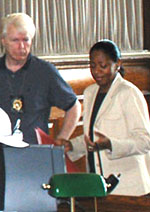
Warden Nadine Felton and webmaster admire court's beautiful old furnishings mixed with modern gadgetry.
|
|
On Aug. 11, 2004, New York Correction History Society curator Nadine Felton, warden of the Correction Academy where NYCHS maintains archives, toured historic Harlem Court, that has been restored to service for civil proceedings, and the building's unrestored 40-cell ex-jail.
Joining her on the tour were NYCHS webmaster Thomas McCarthy and retired Correction Officer Gerald Schultz, whose duties with NYC DOC included service as departmental photographer and who in retirement from DOC continues camera work as a professional free-lance photographer.
Most of the images used in this virtual tour presentation are selections from the hundreds of digital photos Gerald Schultz took that Wednesday. NYCHS appreciates his allowing this use of his exquisite photos. He reserves and retains all rights.
NYCHS appreciates the cooperation and assistance of the Harlem Civil Court, the Harlem Community Justice Center and their personnel for making the actual tour happen and thereby making this virtual tour possible.
The NYCHS-requested tour was arranged with the assistance of Denise Jones, Harlem Civil Court Senior Court Clerk who escorted the visitors.
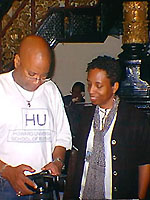
Denise Jones tells Gerald Schultz NYC Civil Court camera restrictions.
|
|
She provided each with a Harlem Community Justice Center (HCJC) folder containing fact-sheets on HCJC programs operating at its offices in the courthouse.
NYS Court Officer Hector Jean-Gilles, with his trusty flashlight illuminating the way in dark passages, also helped escort the group.
Later, Raye A. Barbieri, CSW, Director, Harlem Community Justice Center, generously provided NYCHS with a documentary overview of the HCJC and New York State Unified Court System activities at the courthouse. Text from that overview has been extracted and transcribed into web pages for this presentation. On each of those pages -- the presentation's main text Pages 2, 3 and 4 -- a link to HCJC's own web site is provided.
In each of the three main text pages thus created, small framed versions of Aug. 11, 2004 tour photos have been inserted. Clicking on any one of these small framed versions accesses a page displaying a medium-sized version of that image and one to eight other related medium-sized images. Clicking any of these medium-sized images can access a still larger version.
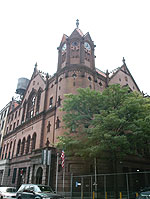
Court/jail complex.
[Click small image to access medium sized version.]
|
|
Some readers will be satisfied with the medium-sized versions that generally provide good overviews at a glance. Other readers may prefer the large, full-frame versions which offer more close-up detail but may require some vertical scrolling.
For example, at left is a small framed view of the Harlem Court:House-Jail complex.
Clicking on it will bring up a page with the medium-sized versions of that view and a related view, each of which, if clicked. will bring up a still larger version. The viewer can navigate through the virtual tour, on either the medium or large
image levels, using the "next' and "previous" directionals, or on the main text pages level, using each small frame image in sequence to gain access to the larger versions.
Those who "click" their way through this virtual tour will notice the contrast between the beautifully restored section of the building (where court proceedings and community-related programs take place every business day) and the unrestored section (where jail operations and custodial staff residency ceased a half century ago never to resume).
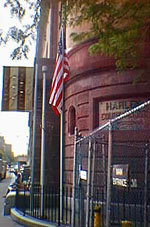
U.S. flag and Harlem Community Justice Center banner at courthouse.
|
|
The ex-jail and the former living quarters are not part of the restoration program. These unrestored parts of the building are outside the mandate of those agencies.
However, to their and their staffs' credit, they demonstrate commendable civic interest in providing what information and assistance they can to researchers studying the history of the ex-jail and former living quarters.
NYCHS hopes that you will find the virtual tour interesting and informative.
In the Harlem Prison we New Yorkers -- indeed all Americans -- have a historic treasure offering a wonderful opportunity to trace visually the roots of the present in a tangible past still standing, a lingering link to a bygone era for us to look upon and ponder.
